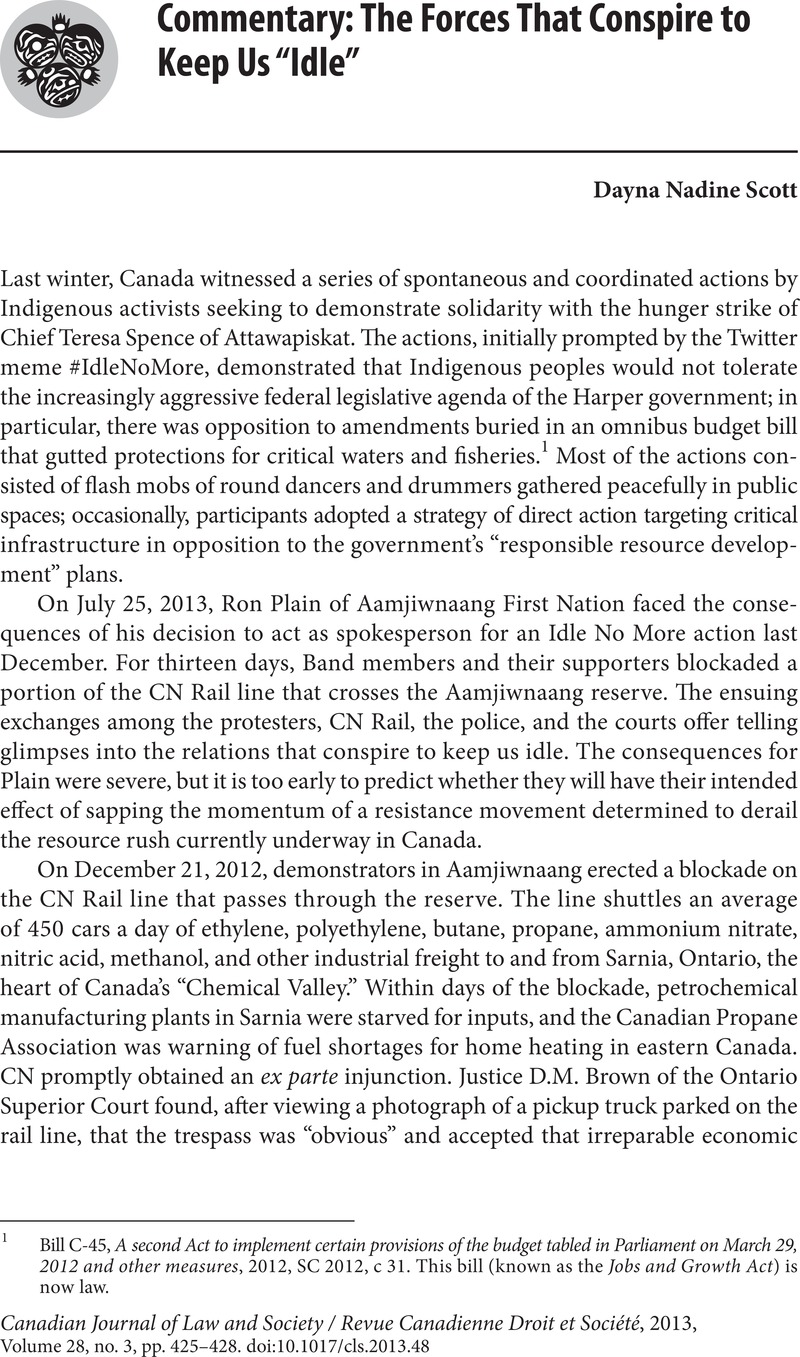Published online by Cambridge University Press: 14 October 2013

1 Bill C-45, A second Act to implement certain provisions of the budget tabled in Parliament on March 29, 2012 and other measures, 2012, SC 2012, c 31. This bill (known as the Jobs and Growth Act) is now law.
2 CNR v Chief Chris Plain, 2012 ONSC 7356, “Injunction Reasons,” Brown J at para 21.
3 Ibid.
4 For a review of these developments, see Ryan Newell, “Only One Law: Indigenous Land Disputes and the Contested Nature of the Rule of Law” (2012) 11 Indigenous LJ 41–72.
5 CNR v Chief Chris Plain, 2012 ONSC 7356, “Reasons for Decision (further corrected),” Brown J at para 19.
6 Ibid.
7 Mike Alamenciac, “Sarnia rail blockade will end when Prime Minister Stephen Harper meets Theresa Spence, protesters say,” Toronto Star (31 December 2012), online: www.thestar.com.
8 Supra note 4 at para 21.
9 Tyler Kula, “Aboriginal protestor Ron Plain ordered to pay $16,500 for role Idle No More Sarnia blockade,” Sarnia Observer (26 July 2013), online: www.theobserver.ca.
10 Supra note 4 at para 41.
11 Indiegogo campaign to raise funds for Plain’s legal defense: http://www.indiegogo.com/projects/legal-defense-fund-to-support-ron-plain.
12 Newell, supra note 1.
13 Recent developments in the jurisprudence had pointed another way. The Ontario Court of Appeal indicated on two occasions that a narrow conception of the rule of law, such as that articulated by Justice Brown, would not suffice in situations where Aboriginal rights or title were at stake. It could be argued, as CN Rail did, that no such rights were at stake in Aamjiwnaang and that protesters were simply voicing their solidarity with Chief Spence. However, as Graham Mayeda states: “Courts are increasingly acknowledging that equitable remedies such as injunctions are not suitable where citizens, both Aboriginal and non-Aboriginal, seek to stimulate public debate about environmental and human rights issues through peaceful protest. The use of such remedies essentially converts a conflict between private parties (the protestors and the [private] company) into a conflict between the courts and the protestors.” Graham Mayeda, “Access to Justice: The Impact of Injunctions, Contempt of Court Proceedings, and Costs Awards on Environmental Protestors and First Nations” (2010) 6 JSDLP 143–76 at 158.
14 Naomi Klein, “Dancing the World into Being: A Conversation with Idle No More’s Leanne Simpson,” Yes! Magazine, March 5, 2012, http://www.yesmagazine.org/peace-justice/dancing-the-world-into-being-a-conversation-with-idle-no-more-leanne-simpson.
15 Canadian National Railway Company v Plain, 2013 ONSC 4806; Decision on Contempt Motion, Thomas J at para 34.
16 Ibid.
17 Newell, supra note 1 at 70.